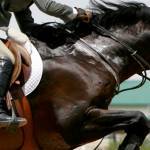Ringbone in Horses

Ringbone, an osteoarthritic condition characterized by degeneration of joint cartilage and formation of abnormal bone, affects horses differently. At its best, the condition impairs a horse’s soundness, causing on-and-off lameness. As its worst, it may prematurely terminate a horse’s athletic career.
Ringbone occurs in two lower-leg joints, the joint between the long pastern and short pastern bones, called high ringbone, and the joint between the short pastern and coffin bones, called low ringbone. In some cases, both joints are affected.
Ringbone forms when joint cartilage is exposed to extreme stress. Cartilage deterioration triggers the body’s inflammatory response, causing the formation of scar tissue. This tissue eventually ossifies.
Loss of cartilage and the ensuing creation of bone around the pastern or coffin joint is painful. The pastern joint is an important component in total-limb shock absorption. Once a significant amount of bone replaces cartilage, the pastern joint permanently fuses, impairing normal movement. The new bone forms a palpable ridge around the affected joint, thus the name ringbone.
Horses involved in high-intensity events such as barrel racing and show jumping are especially prone to developing ringbone. In addition, certain conformation can predispose a horse to the condition, including small hooves, upright pasterns, toed-in or toed-out deviations, uneven weight distribution, and base-narrow or base-wide stances.
Severe cases of ringbone, in which the bony ridge can be felt and weight-bearing lameness is present, do not develop overnight. Unfortunately, the earliest signs of ringbone are only visible through radiographs or MRI. Once the disease progresses, slight swelling or tenderness may be detected in the lower joints. At this point, diagnostic nerve blocks can determine where the pain originates.
Once ringbone is diagnosed, it is important to adhere to a strict care regimen. Fortunately, many forms of therapy are available. Rest, corrective farrier work, and consistent low-impact exercise can slow the progression of the disease. Injections of chondroprotective agents or hyaluronic acid can protect existing cartilage and joint fluid, and corticosteroid injections can reduce inflammation. Other treatment options include extra-corporeal shock wave therapy (ESWT), stem cell therapy, and surgery.
Dietary supplements are another way to combat the effects of ringbone. KER•Flex is an oral glucosamine HCl and chondroitin sulfate supplement that supports joint cartilage. (Glucos-A-Flex for Australian horse owners). EO•3 is an omega-3 fatty acid product that supports heathy joints and reduces inflammation brought about by osteoarthritis.
No perfect course of treatment exists because each horse responds to therapy differently. Horse owners should watch for early warning signs and, if needed, adhere to a consistent treatment plan to slow the progression of this potentially debilitating condition.








